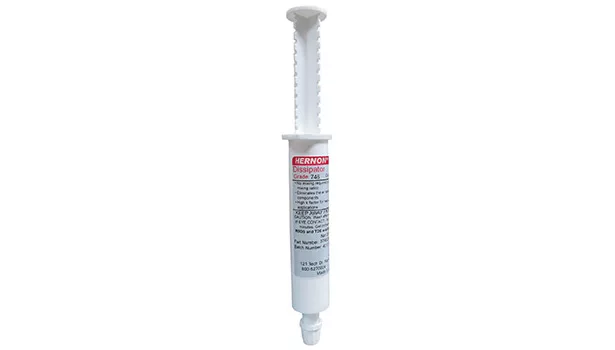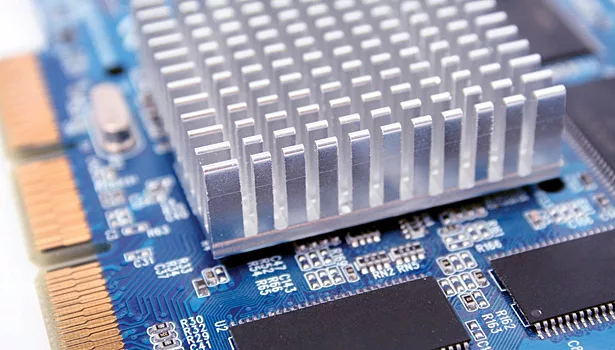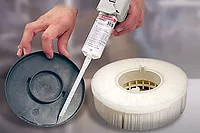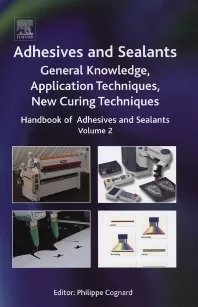Adhesives at Work: Stuck on Heat Sinks
The performance of a heat sink can be improved by using thermal adhesives.



If you’re like most modern-day professionals, each morning you boot up your computer and work late into the day. During that time, you probably don’t even think twice about the heat sink inside your computer, do you?
Although heat sinks are an important part of our computers, many people don’t know what they are. In the simplest of terms, a heat sink is an object that disperses heat from another object. Used in electronic systems as a passive heat exchanger, a heat sink has a thermal conductor that carries heat away from the heat source, such as a CPU, into the surrounding medium. This provides a large surface area for the heat to dissipate, thus cooling both the processor and the heat sink. While most commonly used in computers, heat sinks are also found in cell phones, DVD players, LED lighting fixtures and even refrigerators.
What Determines Effectiveness?
In a computer, a heat sink is an attachment for a chip that prevents the chip from overheating. When properly installed, the heat sink cools down a computer’s processor. Without a heat sink, today’s processors with their increased power levels would run the risk of overheating—potentially destroying an entire system.
In the past, many devices were able to operate without requiring an external cooling device like a heat sink. In these electronics, the conduction resistance from the die to the board needed to be optimized, as the primary heat transfer path was into the primary circuit board. But as power levels increased, heat transfer into the board alone became inadequate.
Much of the heat being generated from today’s computers is dissipated through the top surface of the component. Therefore, a low junction-to-case resistance is important, as is the design and attachment of the heat sink in order to perform properly.
The materials’ thermal conductivity plays a significant role in the overall thermal management process of electronics equipment. The range of conductivity affects the performance and effectiveness of a heat sink. For those more demanding applications, higher conductivity values are required. In turn, for applications needing less heat dissipation, a more moderate conductivity value may be acceptable.
The conductivity equation is dependent on several factors, including air velocities, material choice, component designs and surface treatments. When combined, the heat sink attachment methods, the thermal interface materials and the electronic components themselves affect the temperature ranges of an integrated circuit. It is important to match materials that result in the desired thermal conductivity.
How Do Adhesives Come in?
The performance of a heat sink can be improved by using thermal adhesives. When properly applied, a thermal adhesive fills air gaps between the heat sink and the heat spreader. Filling air gaps is important since heat that is trapped and not dissipated by the components can lead to premature component failure and costly repair and replacement.
Using a thermal adhesive bond to attach a heat sink ensures permanent use and reliable compliance with needed thermal and technical properties. Unlike epoxies, thermally conductive acrylics require no direct mixing. Thermally conductive acrylics also offer several beneficial performance capabilities. For example, surfaces to which the adhesive and activator have been applied can be subjected to virtually unlimited pause times without the properties of the bonding surface deteriorating. In addition, thermal adhesives are easy to apply, self-leveling, require no extensive surface preparation, and offer fast fixturing times, thus considerably reducing both production costs and service repair times.
Thermally conductive two-component adhesives that offer fast curing provide an effective thermal bond between electronic components to heat sinks without the need for mechanical devices. These structural acrylics offer substantial cost advantages compared to mechanical fixtures, which frequently necessitate extensive investments in the production process and equipment. Parts and components can be bonded with thermally conductive, room-temperature-cure adhesives reliably, not only to vertical cooling surfaces but also to metallic housing surfaces and side panels without having to use clips, screws or other mechanical forms of fixture. Thermally conductive acrylic adhesives replace mechanical devices and silicone greases that can trap contaminants.
Some electronic components, such as motherboards and video card processors, may not have mounting holes or mounting space to clamp or rivet heat sinks down. In these instances, thermally conductive adhesives are an ideal solution. The adhesive provides not only a mechanical strength to the bond between the heat sink and the heat source but, more importantly, it fills any gaps to eliminate air (a thermal insulator) from the components.
Thermally conductive structural acrylics of this type provide specific adhesion for bonding electrical heat sink components with high thermal conductivity. Using these products, thermal conductivity is assured and electrical shorting is prevented by the adhesives’ insulation characteristics.
Thermal adhesives have the ability to bond a wide range of materials, as well as dirty and oily surfaces when necessary. Vibration tests of 10 g show no negative effects on the bond. Thermally conductive structural acrylics also offer high peel and high impact strengths. They provide tough, durable, shock resistant bonds. After performing extensive temperature, humidity and aging tests, these types of thermal adhesives not only fulfill but also actually far exceed the basic properties with regard to tensile strength and thermal conductivity.
Case in Point
A line of thermally conductive, room-temperature-cure adhesives has been engineered for bonding electrical components to a heat sink with a controlled gap.* These structural acrylics provide specific adhesion to components with high thermal conductivity and are ideal for use in applications like the bonding of transformers, transistors, microprocessors, and other heat-generating components to PCBs or coolers. They are particularly suitable for bonding LED chips to heat sinks in the production of LED lighting.
A large manufacturer recently tested the adhesive against a competitor’s thermal pad product in the production of LED lighting. The results were positive on all fronts, including operating temperatures that were 6-7°C lower. Temperatures in most electronics are important for increasing the product’s longevity. In the case of LED lighting, it also can yield higher light emission. The thermally conductive adhesive was able to increase life by 15-20% and increase light emission by 5% using the same electrical power input. Another important consideration is that the acrylic in this application was able to lower costs by a multiple of 4-5 times.
The bonding formula is a thermally conductive, acrylic adhesive with self-leveling properties. The leveling action reduces the adhesive to a uniform layer thickness of .005-.007 in. on each application. Gap control ensures the predictable dissipation of heat. The room-temperature-cure adhesive provides up to 1,000 psi of shear strength while delivering a coefficient of thermal conductivity of 69 x 10-6, according to ASTM D696 testing. It also offers a no-mix application, so there’s no need to worry about proper mixing ratios of two-component products and elaborate dispensing pump systems.
To use the adhesive, an activator is applied to one surface and the acrylic is applied to the opposite. Once the components are mated, the adhesive cures to a constant gap of 0.005-0.006 in. Handling strength is achieved in 5 min, with full strength available in 4-24 hours at standard room temperature. The adhesive also provides high dielectric strength to 26.7 kV/mm, according to testing standard IEC 60243-1. It is also resistant to thermal cycling, which is critical in this LED application.
For more information, call (866) 554-4005 or (407) 322-4000, or visit www.hernon.com.
*Dissipator, developed by Hernon Manufacturing, Inc.
How to Bond Heat Sinks with Thermal Adhesives
In order to ensure an optimum adhesive bond between the electronic component and the heat sink, the surfaces of the parts to be bonded should ideally be dry and free from dust and grease. In particular, care should be taken to remove traces of thermal conduction paste or residue on plastic housings, which could prevent reliable bonding. When applying the thermal adhesive, it is recommended to wear gloves and use a lint-free cotton cloth. The ideal processing temperature ranges between 20-28°C.
Once you have your parts ready, apply a small amount of the adhesive to one of the surfaces to be bonded. Then, apply a thin film of an activator to the other surface to be bonded. Slightly turn the parts to be bonded toward each other and join by pressing down firmly for several seconds. Should adjustments be needed, necessary corrections to the position of the parts can be made within 15-30 seconds of bonding
After bonding the two surfaces, wait 5 min for the adhesive bond to be secure. At this time, the bond will have reached approximately 70% of its final strength. After 24 hours, the bond will be fully cured and will have reached 100% final strength. Any excess adhesive that accumulates at the edges can be easily removed at this time.
Looking for a reprint of this article?
From high-res PDFs to custom plaques, order your copy today!








